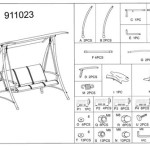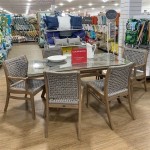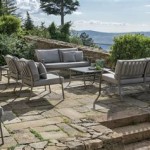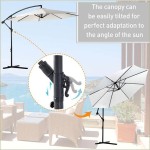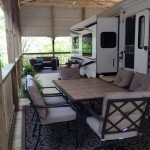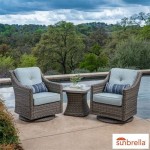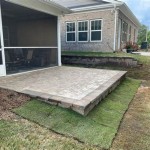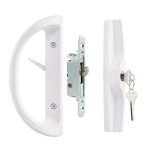Rust-Proof Patio Dining Sets: A Durable Investment for Outdoor Enjoyment
Outdoor dining offers a delightful way to savor meals and enjoy the ambiance of one's surroundings. However, the longevity and appearance of patio dining sets can be significantly impacted by exposure to the elements, particularly the corrosive effects of rust. Choosing a rust-proof patio dining set is therefore a crucial consideration for homeowners seeking to make a durable and aesthetically pleasing investment.
This article explores the various materials and construction techniques that contribute to rust resistance in patio dining sets. It aims to provide readers with the knowledge necessary to select a dining set that will withstand the rigors of outdoor use and maintain its beauty for years to come. Understanding the properties of different materials and the importance of proper maintenance will empower consumers to make informed decisions and maximize the lifespan of their outdoor dining furniture.
Understanding the Enemy: The Rust Formation Process
Rust, chemically known as iron oxide, is the result of a chemical reaction between iron, oxygen, and water. This process, known as oxidation, weakens the metal's structure and causes it to flake and crumble. The presence of salt, acids, or other pollutants in the atmosphere can accelerate the rusting process. Coastal environments, with their high salt content, pose a significant challenge to the longevity of metal furniture.
While iron is a common component in many metals used for outdoor furniture, it's the unprotected iron that is vulnerable to rust. Alloys like stainless steel, which incorporates chromium, resist rust because the chromium forms a passive layer of chromium oxide that prevents further oxidation of the iron. Understanding this fundamental principle is essential for selecting materials that offer inherent rust resistance.
The rust formation process isn't limited to just the primary material of the dining set. Screws, bolts, and other hardware components are equally susceptible. The failure of these smaller parts can compromise the structural integrity of the entire set, even if the main frame is made of a relatively rust-resistant material. Therefore, careful attention must be paid to the materials used in all aspects of the dining set's construction.
Key Materials for Rust-Proof Patio Dining Sets
Several materials offer excellent resistance to rust and are frequently used in the manufacture of patio dining sets. Each material possesses its own unique characteristics, advantages, and disadvantages, influencing the set's overall cost, appearance, and maintenance requirements.
Aluminum: Aluminum is a popular choice for outdoor furniture due to its lightweight nature, durability, and inherent resistance to rust. Unlike iron, aluminum does not contain iron, so it cannot rust. Instead, aluminum forms a protective layer of aluminum oxide when exposed to air, preventing further corrosion. This oxide layer is self-repairing, meaning that scratches or abrasions do not compromise the material's rust resistance. Aluminum is also relatively easy to mold and shape, allowing for various design styles and intricate detailing. However, aluminum can be dented or scratched more easily than some other metals. Powder coating provides an additional layer of protection and enhances the furniture's aesthetic appeal. Powder coating involves applying a dry, free-flowing powder electrostatically to the surface and then curing it under heat to create a durable and uniform finish.
Stainless Steel: As previously mentioned, stainless steel is an alloy containing chromium that forms a protective layer of chromium oxide, preventing rust. The specific grade of stainless steel will influence its level of rust resistance. Marine-grade stainless steel, such as 316 stainless steel, contains molybdenum, which further enhances its resistance to corrosion, making it ideal for coastal environments. Stainless steel is robust, durable, and can withstand harsh weather conditions. It also offers a sleek and modern aesthetic. However, stainless steel can be more expensive than aluminum. Regular cleaning is still recommended to remove dirt and grime, which can potentially lead to localized corrosion over time, particularly in areas with scratches or imperfections in the protective layer.
Teak Wood: While not a metal, teak wood is a naturally durable and water-resistant material often used in outdoor furniture. Teak contains natural oils that repel water and prevent decay, making it highly resistant to rot, mildew, and insect infestation. This inherent resistance also contributes to its rust-proof nature, as it does not contain any metal components that can rust. Teak develops a beautiful silvery-gray patina over time if left untreated, which many find aesthetically appealing. However, teak can be treated with teak oil to maintain its original color and protect it from stains. Though rust-proof in itself, hardware used in the construction of teak furniture should be stainless steel or another rust-resistant material to prevent corrosion around the joints.
Resin Wicker: Resin wicker is a synthetic material made from polyethylene or PVC that is woven onto a frame, often made of aluminum. This combination offers excellent rust resistance. The resin itself is waterproof and resistant to mildew and fading. The aluminum frame provides a lightweight and durable base that will not rust. Resin wicker is available in a variety of colors and styles, providing a versatile option for outdoor dining sets. It is also relatively easy to clean and maintain. The quality of the resin varies, so it's important to choose a high-quality resin that is UV-resistant to prevent fading and cracking over time.
Factors Influencing Rust Resistance Beyond Material
While the material of construction is paramount, several other factors contribute to the overall rust resistance of a patio dining set. These include the quality of the finish, the design and construction of the set, and the level of maintenance provided by the owner.
Powder Coating and Finishes: The application of a high-quality powder coating or other protective finish can significantly enhance the rust resistance of metal furniture, even if the base material is not inherently rust-proof. Powder coating creates a barrier between the metal and the environment, preventing moisture and oxygen from reaching the surface and initiating the rusting process. The quality of the powder coating is crucial; a poorly applied or damaged finish will compromise its protective capabilities. Regular inspection of the finish is recommended to identify and repair any chips or scratches that may expose the underlying metal.
Design and Construction: The design and construction of a patio dining set can also influence its susceptibility to rust. Sets with intricate designs or complex joints may have areas that are difficult to clean and maintain, creating opportunities for moisture to accumulate and cause corrosion. Similarly, sets with poorly designed drainage systems may trap water, accelerating the rusting process. Choosing sets with simple, clean designs and good drainage can help minimize the risk of rust formation. Welded joints are generally more water-resistant than bolted connections, but both should be properly sealed to prevent moisture intrusion.
Maintenance and Care: Regular maintenance is essential for preserving the rust resistance of any patio dining set, regardless of the material used. Cleaning the set regularly with mild soap and water will remove dirt, grime, and other contaminants that can contribute to corrosion. Promptly addressing any scratches or chips in the finish will prevent rust from spreading. Applying a protective coating or sealant periodically can further enhance the furniture's resistance to the elements. For teak furniture, applying teak oil can help maintain its natural color and protect it from stains. During the off-season, storing the dining set indoors or covering it with a waterproof cover will protect it from harsh weather conditions and prolong its lifespan.
Selecting a rust-proof patio dining set requires careful consideration of the materials used, the quality of the construction, and the level of maintenance required. By understanding the factors that contribute to rust resistance, consumers can make informed decisions and invest in a dining set that will provide years of enjoyment in their outdoor living space.

Unbranded Gray 7 Piece Rust Proof And Uv Acacia Wood Outdoor Dining Set With Beige Cushions Armrest Ff 15e W

Nuu Garden 3 Piece Cast Aluminum Patio Bistro Set Rust Proof Outdoor Furniture

Joivi 5 Piece Outdoor Patio Dining Set For 4 Cast Aluminum Cushioned Chairs With Umbrella Hole Lattice Design Antique Broe

Pellebant Black 11 Of Pieces Rust Resistant Aluminum Adjustable Expandable Outdoor Dining Set With Stackable Arm Chairs Pb Dc5040gry The Home
Sunvilla Havana 7 Piece Outdoor Patio Dining Set Costco

Sophia William 5 Piece Outdoor Patio Metal Dining Set Swivel Chairs And Table Black

9pc Patio Dining Set With Expandable Steel Table Padded Arm Chairs Captiva Designs Weather Resistant Outdoor Furniture

Nuu Garden 3 Piece Cast Aluminum Patio Bistro Set Rust Proof Outdoor Furniture Scd004 01a The Home

Withniture Outdoor Table With Umbrella Hole Patio Dining 42 Cast Aluminum Rust Resistant Round
Sunvilla Vineyard 9 Piece Fire Outdoor Dining Set Costco

